Table of Contents
Did you know that according to the EPA, Americans spend 90% of their time indoors? Experts in the documentary film, MOLDY suggest that more than 50% of houses in the U.S. have mold problems and 28% of the population have genes that make them highly susceptible to mold-related health issues.
If your health is a priority – you need to know the symptoms of mold exposure so you can act quickly to protect yourself and your family.
In this article we’ll share common signs of mold exposure so you can have the upper hand against this nasty fungus.
What is (black) mold?
To understand what we’re dealing with, let’s try to break down what black or toxic mold is, how it affects people, and who is susceptible to it. Understanding your enemy gives you an advantage.
All mold varieties at certain levels can cause allergic reactions and be potentially dangerous to your health.
We’ve all probably heard the terms “black mold” and “toxic mold.” Black or toxic mold refers to molds that may produce mycotoxins or toxins. In the category of black or toxic mold, most attention is given to health concerns from Stachybotrys, certain varieties of Aspergillus, Penicillium, Chaetomium, Trichoderma, Phoma, and Fusarium.

How does mold affect people?
According to the Center for Disease Control and Prevention, mold exposure is not connected to any specific symptoms. But, immediately after this sentence, the website stresses that any mold should be removed from a building.
It is clear, however, that mold exposure can cause certain symptoms, but they might be different from person to person. That makes sense – our immune systems are different, and we have different pre-existing conditions, so why should mold treat us the same?
When mold grows in a house, it releases spores into the air that contain mycotoxins. Our bodies are generally accustomed to the amount and types of mold we’re exposed to outside. When indoor mold levels are high relative to outdoor levels, or more harmful varieties of mold are present, allergies and other health issues can result.
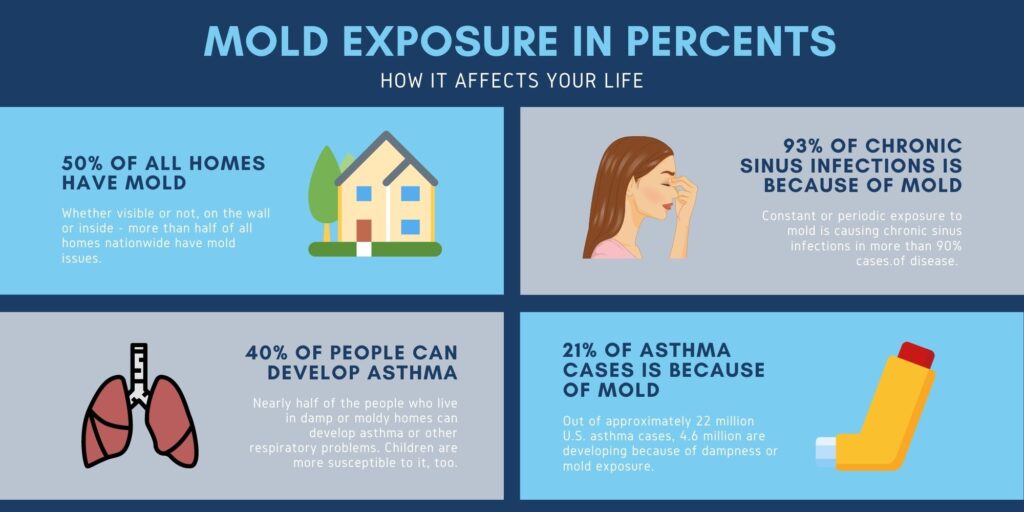
Who is susceptible to mold poisoning?
Some people develop symptoms rather quickly, when others, even under the same conditions, might not experience any symptoms at all. People with existing health problems are more susceptible to mold-related issues.
We will mention three primary health conditions that make an individual more likely to develop mold exposure symptoms: chronic diseases, allergies, and immune suppression.
People with Chronic Diseases
Individuals with the chronic respiratory disease might develop mold poisoning symptoms after inhaling just a small amount of mold spores. The more spores inhaled – the worse their condition and symptoms will be.
Therefore, people with asthma or obstructive pulmonary disorder need to be on full guard when dealing with mold.
People with Mold Allergies
If a person is allergic to mold, the reaction for mold exposure might be more intense. It can show itself as a respiratory reaction or on the skin.
Because people with allergies are more sensitive, it is important to minimize contact with moldy areas or infected air, as longer exposure can lead to more severe problems.
People With Suppressed Immune System
Also, those with immune suppression are at high-risk for developing fungal infections after mold exposure. Even if your immune system normally works well, but you just had the flu – your immune system will likely be weak after fighting the virus.
Alcohol, smoking, and bad nutrition also suppress your immune system, making you more susceptible to mold poisoning.
What are the symptoms of mold exposure in humans?
Depending on the type of mold and the way an individual was exposed to it, the symptoms may vary. Some people experience mold poisoning symptoms seasonally, while others are affected year-round.
Again, in some people, mold poisoning might be asymptomatic (with no obvious symptoms), while in others, it might cause a variety of problems. By the way, your pets are also affected by mold poisoning.
Mold Allergy Symptoms
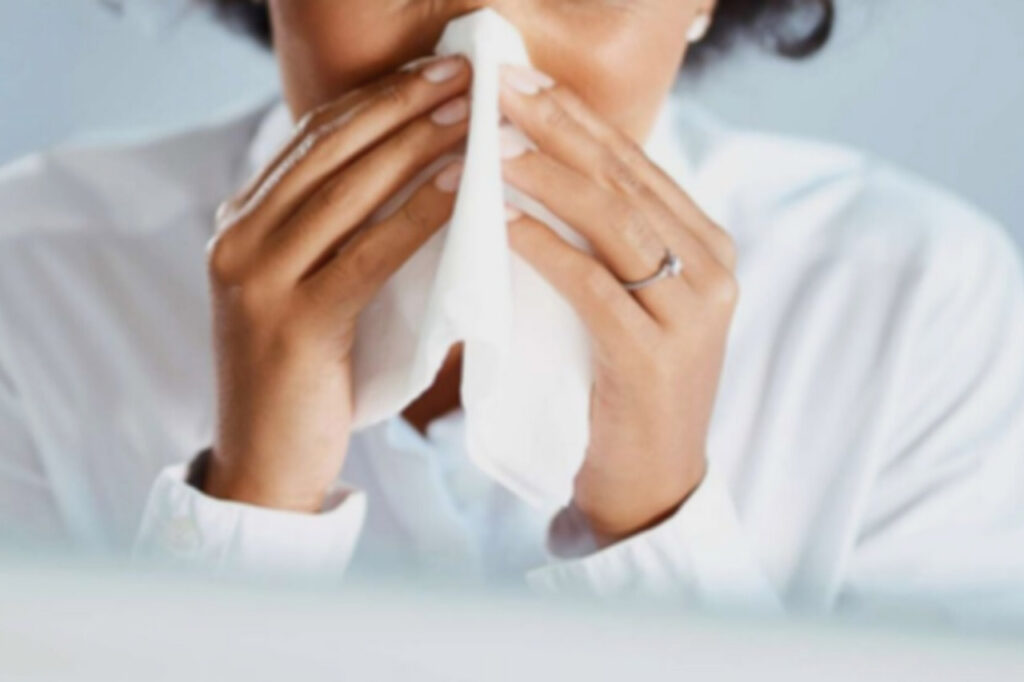
As we mentioned before, people with allergies are more susceptible to mold exposure than others. Living in a house with unhealthy mold conditions, being exposed to it at work or at school might cause the following symptoms:
- Stuffy or runny nose
- Eye irritation (watering, red eyes, itching)
- Sore, dry throat
- Dry cough or sneezing
- Skin irritation (rash, skin scaling)
- Wheezing or shortness of breath
- General malaise
- Brain fog (difficulty focusing)
The symptoms might be more severe if the mold exposure continues. It could also make current health issues worse if not addressed, which includes asthma and lung diseases.
Mold Infection Symptoms
Mold infections are uncommon, as they don’t occur in people with properly working immune systems. But a person may become more susceptible to mold infections if the immune system is suppressed by medications, diseases, tobacco, or alcohol. People with lung problems or previous conditions are more likely to develop an infection.
The infection might not cause symptoms in the beginning. With time, it might progress and cause symptoms like:
- Fever
- Chest pain
- Wheezing or difficulty breathing
- Wet cough (with mucus or blood)
If you notice these symptoms, talk with your doctor and follow his advice closely to stop the inflammation.
What Happens if You Eat Food with Mold?
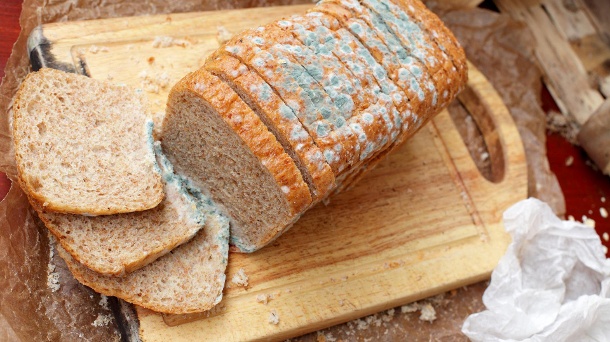
The thought of eating something moldy likely makes you want to gag. Most of the time, this is the only symptom you’d get after eating moldy food. If something’s not right with your immune system and you eat something moldy, you might experience symptoms like:
- Vomiting
- Nausea
- Diarrhea
- If you are allergic to mold, those allergy symptoms may be triggered also
If you notice mold on your food that you don’t want to throw away, consult the USDA’s guide on handling moldy food.
Can Doctors Test for Mold Exposure?

If you are aware of mold growth in your home and you feel sick, inform your doctor about the mold and your symptoms right away. But sometimes you can’t see mold, and it is not clear whether it’s mold exposure that’s made you sick or not.
Because mold allergy or mold exposure symptoms can resemble that of other allergies, the doctor will typically start by asking about your medical and family medical history. Additionally, doctors usually run tests for mold exposure which may include one or more of the following:
- Skin test for reactions to allergens, including mold
- IgG mold antibodies test to see the immune system’s reaction to molds. A positive test means that an individual was or is currently exposed to mold
- Urine mycotoxins test
- A fungal culture of the nasal sinuses
The type of testing you’ll receive depends on the doctor you visit, so be sure to ask questions ahead of time so you can feel confident in your diagnosis.
What Does Black Mold Exposure Treatment Look Like?
Just like the diagnosis, the treatment of mold exposure differs from doctor to doctor. One thing most doctors will advise you to do is to test for and, if needed, remove any unhealthy mold conditions from your home. Even if the treatment will help in the short-term, it won’t be effective over the long-term if your indoor environment isn’t improved.
To treat the symptoms, doctors may suggest:
- Over-the-counter medication. Medicine that would decrease the airway inflammation and suppress the allergic reactions.
- Nasal sprays to deal with a runny or stuffy nose or rinses to clear your nasal passages from inhaled mold spores.
- Regular allergy medicine
A person’s immune system must be working properly to fight mold symptoms, so changes in a lifestyle or diet might be necessary. In more severe allergy cases, doctors prescribe immunotherapy to relieve symptoms
How to Know If You Have Black Mold in Your House?
Mold isn’t always visible. If you can see mold, it’s only a sign of the real potential health risk – the unhealthy levels of harmful types mold in the air of your home or workplace.
Airborne mold is all around us – in both the outdoors and indoors. The types and amount of mold determines the potential health risk. Most of us are accustomed to the varieties and amounts of mold present in our outdoor environments.
Healthy indoor environments will have mold conditions similar to or better than those in the surrounding outdoors. Over time, because of moisture (ie. humidity and water leaks), many indoor spaces develop unhealthy types and/or unhealthy levels of airborne mold that can be harmful to you or your pets.
These signs could mean you have unhealthy mold conditions in your house:
- Allergic symptoms (especially in winter when outdoor allergens are low)
- A damp or musty odor in one or more places
- Frequent headaches
- Difficulties breathing
- The air in the home feels different
- Your house has been flooded or currently has leaks
- You previously tried removing mold yourself
Take note of how you feel in and out of the house. If the symptoms disappear or decrease when you’re out and about, then you might have a mold problem, yes, even if you can’t see mold.
To see if you have a mold problem, you can have an inspection and air quality test performed by a local mold testing company. The results of this test will typically be available within a week and will tell you the types and amount of mold present. Getting the air in your home or workplace tested is a good way to objectively determine if a mold problem is present or not.
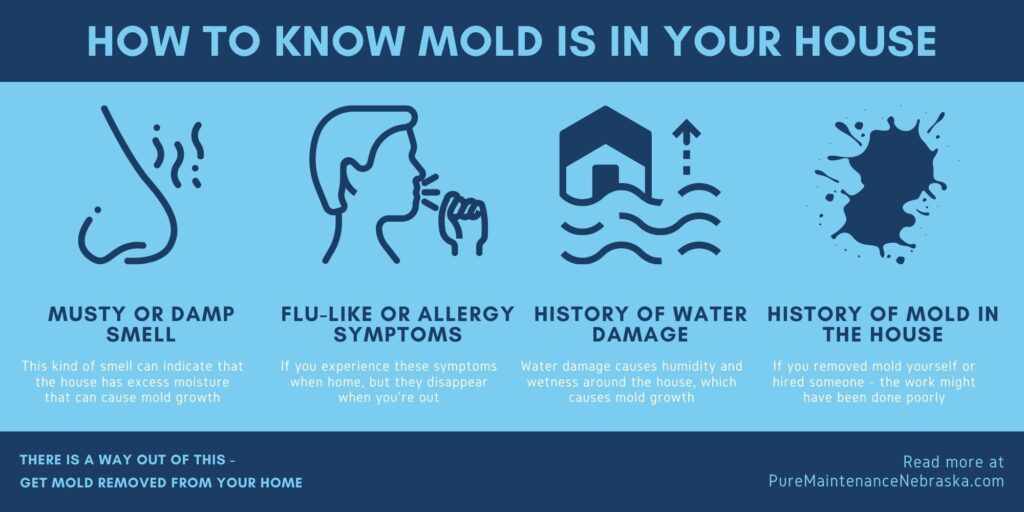
How to Remove Mold
Do it yourself
There are plenty of DIY mold removal options for you on the web including scrubbing with bleach, vinegar, or hydrogen peroxide. Some of these are more effective than others. If the problem is minor and localized, these may suffice. After DIY treatment, it may be good to have an air quality test taken to measure the effectiveness of your work.
Hire a professional mold removal company
If the problem is more than minor, DIY methods will likely only remove the appearance of mold for a short time. For more serious problems, the best approach is to hire a certified and reputable local mold removal company.
Most mold remediation companies will recommend demolition of the infected part of your home to literally remove the mold, so keep in mind that you might have additional expenses to restore a portion of your house. On top of that, the process might take several days.
If you are looking into demolition-free mold removal, then consider companies that use a dry fog technique. When properly done, this method not only kills mold without demolition, but it also takes less than a day to complete.
We have the equipment and expertise to remove mold completely AND prevent it from coming back for at least 90 days! Learn More »
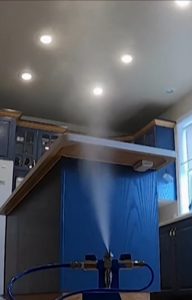

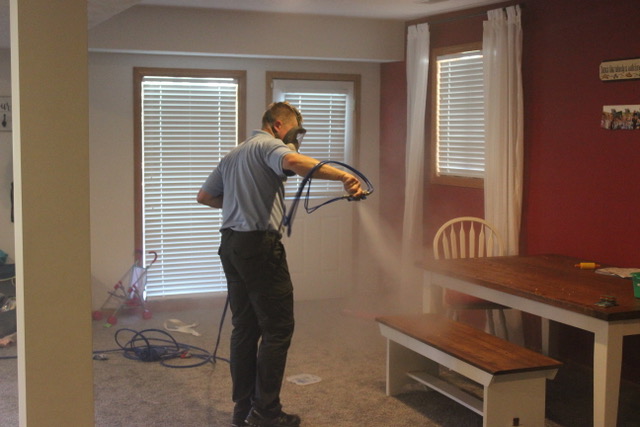
How to Prevent Mold
Whether you just got rid of the mold or you don’t ever want to see it in your house – you need to know the mold prevention rules. To prevent mold from appearing in your house:
- Keep the humidity levels between 30% and 50%
- Often check your house for leaks and signs of mold
- Keep air moving in the home, especially in the winter to prevent condensation on windows
- Use kitchen or bathroom fans to take out excess moisture after/during usage
- Address any water-damage issues quickly
Small investments in prevention can go long ways…and keep more cash in your pocket!
